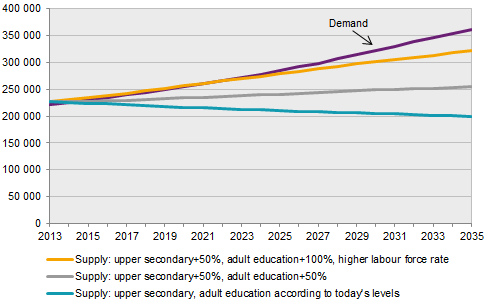Theme Labour Market - Trained health and social care workers - Today and in the future:
Considerable investments required to combat shortage of trained healthcare personnel
Statistical news from Statistics Sweden 2015-12-16 9.30
A significant shortage of trained healthcare personnel is expected in the future. Even if the interest among upper secondary school students was to increase and considerably more were to graduate from adult education, there is a great risk that the number of those trained in healthcare would not suffice the demand in 2035.
The trend toward a greater share of elderly persons in the population is expected to continue during the next 20 years. This will lead to an increased need for personnel among the elderly care sector in particular. Today about 220 000 persons with upper secondary healthcare training are gainfully employed. According to Statistics Sweden's Trends and Forecasts 2014, it is estimated that a shortage of 160 000 persons with healthcare training will occur in 2035.
In the report Trained health and social care workers - Today and in the future a number of scenarios are presented that show to what extent the future shortage would be reduced if more people graduate from healthcare training and if the labour participation rate increases.
Investment in adult education has a great effect
In one scenario, we assume that the interest for healthcare training in upper secondary school and the number of graduates from adult education increases by 50 percent. Even so, the shortage is expected to be considerable in the future, but drops from 160 000 to 105 000 in 2035. In the most "positive" scenario of the study, it is assumed that the interest for healthcare training in upper secondary school will increase by 50 percent at the same time as the number of graduates from adult education is doubled. In addition, it is assumed that persons trained in healthcare will take part in the labour force to a greater extent than today. Under these conditions, a balanced situation is expected between supply and demand up until 2025. However, after 2025 further measures will be needed to prevent the shortage that otherwise is expected to reach 40 000 persons in 2035. The scenarios show that increased graduation from adult education has the greatest effect to reduce the shortage.

Source: Trends and forecasts 2014 (Statistics Sweden) as well as alternative estimations
Training of personnel will be needed
Significant investments are required in the educational system to combat the future shortage of trained healthcare workers. If this shortage is not reduced it will be necessary to hire persons without healthcare training to a greater extent. In the future it will be even more important that employees are given the opportunity to acquire the required skills in other ways.
Foreign born persons an important resource
In the future, foreign born persons are expected to comprise a larger share of those in actively working ages. Faced with the growing need that is expected in healthcare, those who immigrate to Sweden with skills in healthcare are an important asset.
Definitions and explanations
Participation in the labour force
The labour force consists partly of those who work (gainfully employed persons) and partly of those who do not work, but are available for work. Labour force participation shows the proportion of the total population that is included in the labour force.
Publication
Feel free to use the facts from this statistical news but remember to state Source: Statistics Sweden.
